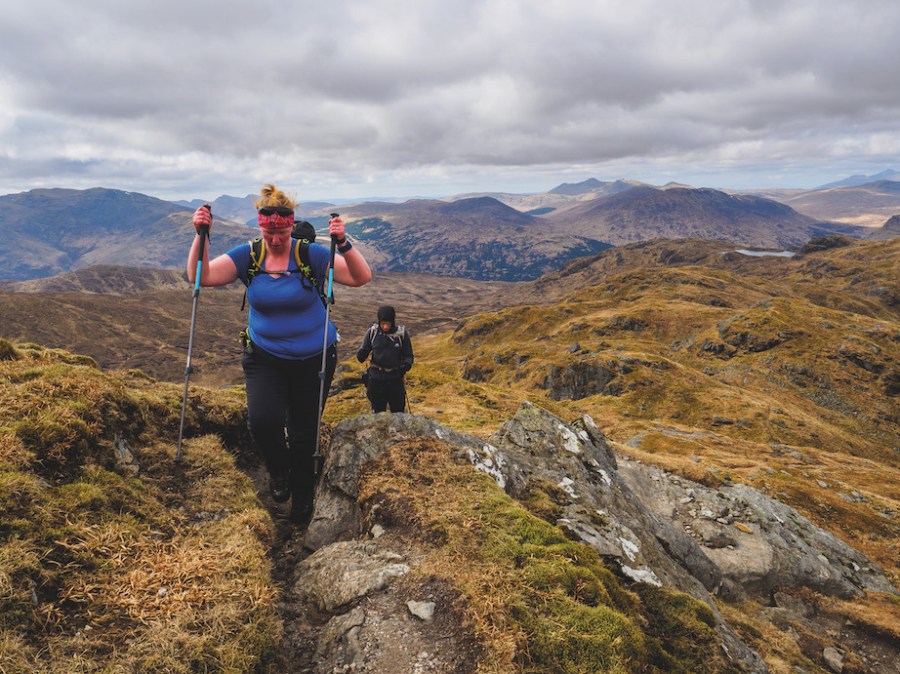The pioneering role of women in the history of hiking, hillwalking and mountaineering has been hidden for too long, argues Kerri Andrews.
Main image: Kerri Andrews on Beinn Chabhair, Scottish Highlands
A few years ago I lived in Boston for a while. One Saturday I took the train out to Concord, seat of the American Revolution and home to writers galore: Ralph Waldo Emerson, Louisa May Alcott, Nathaniel Hawthorne, and Henry Thoreau. I hiked from the train station into town, and from there to Emerson’s house. A newly-made walk linked Emerson’s home with Walden Pond, where Thoreau famously lived in a log cabin he built, and I took the opportunity for a proper wild walk in America.
The woodland was delicious, with spring foliage full of birds I didn’t recognise. But when I arrived at Walden Pond I realised it was less than a mile from town. Thoreau had built his ‘wild’ cabin twenty minutes from his parents’ home, and popped round every Sunday for tea.
Thoreau is held up as a pioneer of wilderness, of a rugged adventurer finding himself in solitude, but he was only at most a twenty-minute stroll or a week away from a hot dinner and someone doing his laundry. In contrast, writing about genuinely adventurous women in the wild can be difficult to find. Shelves groan under the weight of men’s derring-do, and you’d be forgiven for thinking that women never ventured out at all. But they most certainly did.
Pioneer
A pioneer of mountaineering was Dorothy Wordsworth, who in 1818 climbed Scafell Pike – one of the first to do so. She never published her account, choosing instead to write about it in letters to friends. Later, her brother William would ‘borrow’ her words for inclusion in his own, best-selling guide to the Lake District. Dorothy received no credit.
Around the same time Ellen Weeton, a governess from Lancashire, undertook a solo climb of Snowdon, using her bonnet to protect her from the sight of sheer drops down the mountainside, and resisting attempts from patronising men to help her. She wrote about her experiences in letters to friends. They were published a century later.
There are dozens of other women, from the eighteenth century to the present day, who have written about walking, climbing, running mountains. Not all of them published their writing, it is true, but books claiming to write the history of walking or mountaineering without including women’s stories are telling only part of the tale.
Why does this matter? Because women and girls continue to receive the message that the outdoors is not for them – from well-documented and apparently endless evidence of harassment in public places, to an absence of role models in literature about the outdoors. We all know the adage ‘if you can see it you can be it’, but if girls cannot see people like them in the wild, they will struggle to be people in the wild.
Role models
So what can we do? We can start by refusing to accept the sexist and exclusionary narrative we’re being fed that only men have stories to tell about the outdoors. We can buy books by women adventurers – and there are lots to choose from. We can demand our local bookshops stock a bigger variety of adventure stories – including those by women. And we can put these books into the hands of the girls and women in our lives, so that they know that people like them have done the most incredible things, and been in the most amazing places in the world. If we do this, publishers and agents will have more incentive to commission writing from a broader range of voices still, and we will all benefit from having a bigger choice of adventure stories to enjoy.
It took me until my thirties to find role models for the sort of walker I wanted to become – and all of them were more adventurous than Henry Thoreau turns out to have been. Who knows how far our girls might go, if we can but show them the way.
Kerri Andrews is a senior lecturer in English Literature at Edge Hill University and the author of Wanderers: A History of Women Walking







